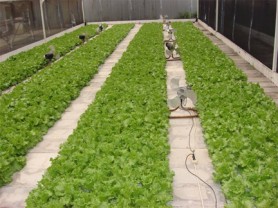– hydroponics will help mitigate effects of climate change – Homenauth
The National Agricultural Research Institute (NARI) is continuing its aggressive promotion of one of the world’s oldest farming techniques as an efficient, environmentally friendly and cost-effective approach to enhancing productivity in an environment that offers particular advantages for small-scale farmers.

Director of NARI Dr Oudho Homenauth told Stabroek Business that subsistence and small-scale farmers could benefit from turning to hydroponics, a farming technique that dates back more than 2,000 years, which Homenauth said is as relevant to contemporary food production as it was to its first-known application all those centuries ago.
Hydroponics, the technique of growing plants without using soil, involves the use of a suitable fastening system to hold plants in place so that the roots develop in a liquid medium of nutrients dissolved in water without any type of substance or solid support for anchoring the roots. The technique makes it possible to cultivate rapid growth and nutritive plants in a simple, clean and inexpensive way that does no damage to the environment.
Homenauth told Stabroek Business that NARI’s efforts to infuse hydroponics into local agriculture was part of the Ministry of Agriculture’s broader effort to enhance the farming community’s awareness of techniques that could mitigate the effects of climate change. He added that apart from the fact that hydroponics could be applied to farming on an all-year-round basis, the technology could also result in the realization of quality produce since it required a reduced level of fertilizer.
Guyanese businessman Gerald Mekdeci has led the way locally in adapting the hydroponics culture to agriculture in Guyana with a more than $40 million investment in a project in Georgetown which commenced with the construction of the first greenhouse in 2007.
NARI, meanwhile, is pushing its own experimentation with what its director describes as “soil-less agriculture”. The focus of the institute, Homenauth said is on imparting to persons involved in agriculture “the simple” technique associated with the application of hydroponics to farming. “On a small scale we particularly recommend hydroponics for women, for example, who are seeking to use agriculture to enhance their families’ food security,” “What makes the technique appealing is the fact that it lends itself to being pursued on a small scale, in small spaces and at relatively little cost,” Homenauth said.
What is known as the “pure hydroponic culture,” involves the use of a suitable “fastening system” to hold the plant in place so that it develops its roots in a liquid medium comprising nutrients dissolved in water without any type of substrate or solid support for anchoring its roots.
Homenauth said a variant of the practice that can be applied here may involve the use of sand, or rice husk as the fastening agent, leaving the roots suspended in the nutrient solution.
The technique, Homenauth said, makes it possible to successfully cultivate rapid-growth and nutritive plants in a clean, simple and inexpensive way without doing damage to the environment. He said that when hydroponics is pursued on a small scale, people can actually utilize the resources that they have on hand. “Shade is important and the hydroponic culture requires careful attention but does not demand constant or permanent work,” Homenauth said.
He told Stabroek Business that some food crops including lettuce, celery, pak choy and eschallot lend themselves to being grown successfully using the hydroponic culture. “These crops are easy to grow and can be cultivated on an all-year-round basis using the hydroponic culture,” Homenauth said.
The nutrient solution or liquid fertilizer upon which plants cultivated using the hydroponic method rely for their sustenance is widely available in Guyana. Homenauth said the solution, which contains the 17 elements necessary for hydroponic cultivation is now available in local shops at around $40 per litre.
In September last year NARI set up an experimental hydroponics facility which is currently testing three different solutions along with different growth medium and different crops. NARI’s plans include the staging of a number of in-house sessions designed to train farmers and potential farmers in the application of the hydroponics culture. “We are hoping too that we can do more aggressive promotion of hydroponics in Regions Two, Three, Four, Five, Six and Ten,” Homenauth said. This year NARI also intends to develop more demonstration facilities to help farmers develop techniques associated with the use of the hydroponics culture. Two such facilities already exist at Mon Repos and Timehri on the East Bank Demerara.

